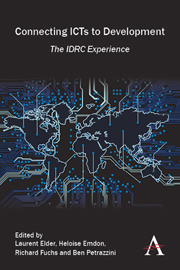Book contents
- Frontmatter
- Contents
- Acknowledgments
- Introduction Part I From Heresy to Orthodoxy: ICT4D at IDRC
- Introduction Part II From Beginning to End to Beginning Again
- Chapter 1 Catalyzing Access through Social and Technical Innovation
- Chapter 2 Catalyzing Access via Telecommunications Policy and Regulatory Research
- Chapter 3 Access to Knowledge as a New Paradigm for Research on ICTs and Intellectual Property
- Chapter 4 ICTs and Social Inclusion
- 5 Access and Usage of ICTs by the Poor (Part I)
- Chapter 6 Local Economic Opportunities and ICTs: How ICTs Affect Livelihoods (Part II)
- Chapter 7 Research on eHealth across Health Systems: Contributions to Strengthen a Field
- Chapter 8 Making the Grade: The Role of ICTs in Providing Access to Knowledge
- Chapter 9 E-Government for Development: ICTs in the Public Sector and the Evolving Citizen–Government Relationship
- Chapter 10 Innovations in Evaluating ICT4D Research
- Chapter 11 Conclusions: A Decade of Innovation that Matters
- Epilogue Into the Future: New Opportunities and Threats in a Global Networked Society
- Author Biographies
Chapter 2 - Catalyzing Access via Telecommunications Policy and Regulatory Research
from Introduction Part II - From Beginning to End to Beginning Again
Published online by Cambridge University Press: 05 March 2014
- Frontmatter
- Contents
- Acknowledgments
- Introduction Part I From Heresy to Orthodoxy: ICT4D at IDRC
- Introduction Part II From Beginning to End to Beginning Again
- Chapter 1 Catalyzing Access through Social and Technical Innovation
- Chapter 2 Catalyzing Access via Telecommunications Policy and Regulatory Research
- Chapter 3 Access to Knowledge as a New Paradigm for Research on ICTs and Intellectual Property
- Chapter 4 ICTs and Social Inclusion
- 5 Access and Usage of ICTs by the Poor (Part I)
- Chapter 6 Local Economic Opportunities and ICTs: How ICTs Affect Livelihoods (Part II)
- Chapter 7 Research on eHealth across Health Systems: Contributions to Strengthen a Field
- Chapter 8 Making the Grade: The Role of ICTs in Providing Access to Knowledge
- Chapter 9 E-Government for Development: ICTs in the Public Sector and the Evolving Citizen–Government Relationship
- Chapter 10 Innovations in Evaluating ICT4D Research
- Chapter 11 Conclusions: A Decade of Innovation that Matters
- Epilogue Into the Future: New Opportunities and Threats in a Global Networked Society
- Author Biographies
Summary
The International Development Research Centre's (IDRC's) “Information and Communications Technologies for Development” (ICT4D) program realized in the early days of its programming that a key part of catalyzing access to information and communications technologies (ICTs) involved attention to policy and regulatory environments. This was needed to understand the policy bottlenecks that hindered access to and use of ICTs. On its own, catalyzing access through demonstrating social and technical innovations is not enough to build an inclusive knowledge society and economy in the developing world. ICT policy and regulation play a key role in determining market and pricing conditions that influence the extent to which people can access ICTs. A key element of IDRC's ICT4D program was funding research on policy and regulatory frameworks, their effectiveness or lack thereof and policy interventions that would lead to increased access.
Two IDRC-funded projects show how social and technical innovations depend heavily on appropriate policies and regulation for increased access. Beginning in 2003, IDRC funded a project that explored the potential of low-cost WiFi technology to overcome the high cost of Internet connectivity in Africa. However, the project soon found that existing regulatory frameworks hindered the deployment of community wireless networks on the continent (Morris and Makan 2008, 3). In some countries, regulatory frameworks slowed the implementation of wireless technology. In others, like South Africa, community wireless networks were actually illegal. So, to use wireless technology as an effective and low-cost method to extend connectivity to underserved populations, changes to the telecommunications regulatory framework were needed in many countries.
- Type
- Chapter
- Information
- Connecting ICTs to DevelopmentThe IDRC Experience, pp. 57 - 74Publisher: Anthem PressPrint publication year: 2013

